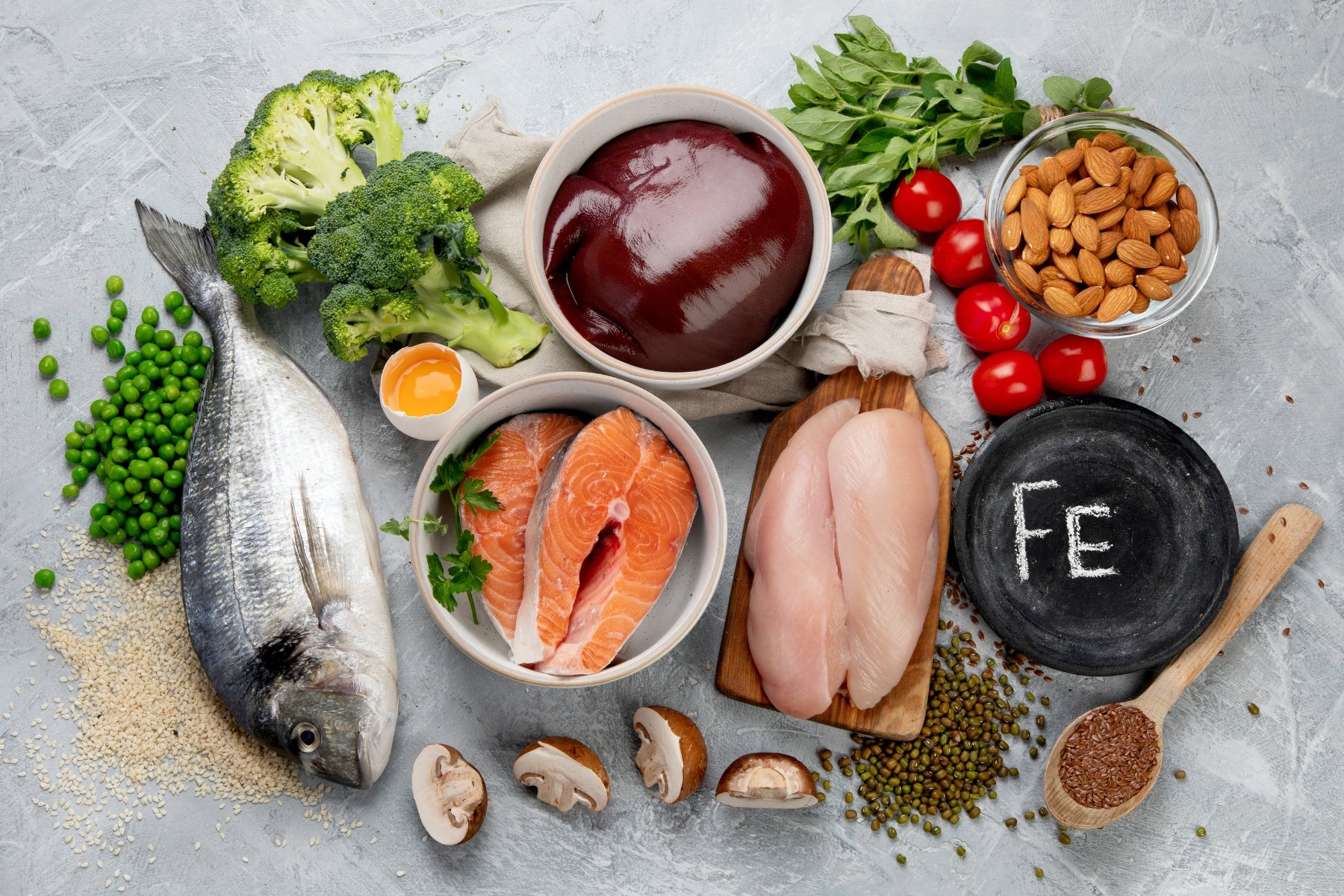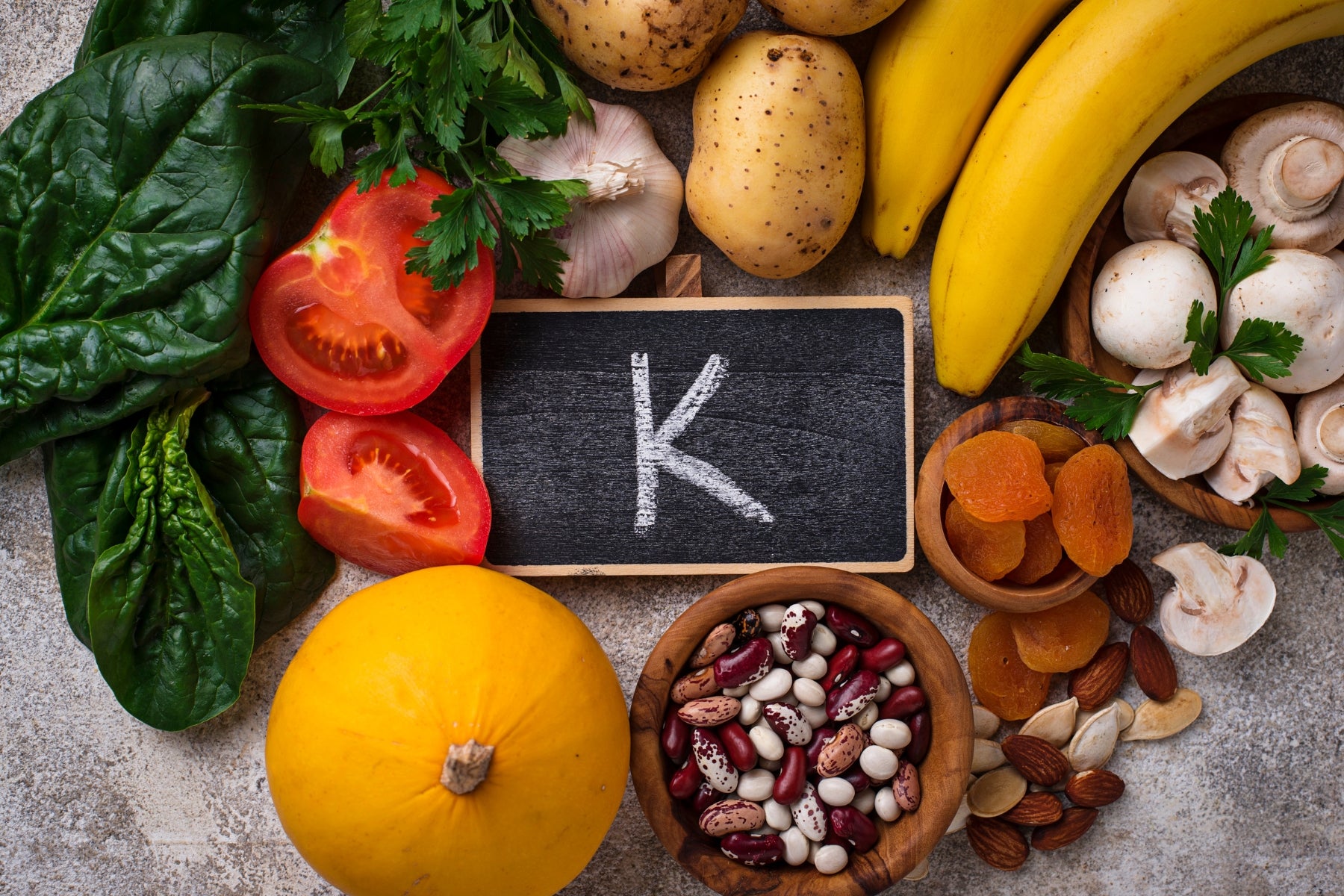What role do minerals play in your body?
Minerals are required for the correct composition of body fluids, tissues, bones, teeth, muscles and nerves. Minerals also play an important role in maintaining a healthy nerve function, regulating the state of tension of the muscles and supporting a healthy cardiovascular system.
Like vitamins, minerals also enable your body to fulfill your biochemical functions, including:
- Cell growth
- regeneration
- Energy production
- Using vitamins and other micro and macronutrients 2
An optimal balance of minerals in your body is essential for general health. If a mineral content is from balance, all other mineral content can be affected. If this type of imbalance is not corrected, a chain reaction of imbalances can be used.
However, minerals are very stable compared to vitamins and cannot be destroyed by heat or light. No matter whether baked, cooked, fried or raw - the minerals in your food keep their nutritional value. 3
What minerals are there and how much do you need?
Iron for growth and a healthy hormone balance
Iron is a mineral that requires the body for growth and development. Your body used Iron to produce hemoglobin, a protein contained in red blood cells, which transports oxygen from the lungs to all areas of your body, and from myoglobin, a protein that supplies the muscles with oxygen. Your body also needs iron for the production of some hormones. Adults need approx. 14 mg of iron per day. 18
How is iron deficiency expressed?
In the short term, too low iron supply does not cause obvious symptoms. The body uses its saved iron in the muscles, the liver, the spleen and the bone marrow. However, if the amounts of iron stored in the body become too low, iron deficiency anemia begins. The red blood cells are smaller and contain less hemoglobin. As a result, the blood transports less oxygen from the lungs through the body.
The symptoms of iron deficiency anemia include a disturbance in the gastrointestinal tract, weakness, fatigue, lack of energy as well as problems of concentration and memory. In addition, people with iron deficiency anemia are less able to combat germs and infections, to work and to do sports and to control their body temperature. Infants and children with iron deficiency anemia can develop learning difficulties. 19
Natural iron sources (per 100 g)
Liver: 23 mg
Dark chocolate: 17 mg
Pumpkin seeds: 15 mg
Oysters: 9 mg
Cashewkerne: 6 mg
Potassium for healthy cells
Potassium is available in all tissues of your body And is required for normal cell function because of its role in regulating the fluid volume of your cells. The daily need for potassium for adults is around 2000 mg. 6
How does potassium deficiency comment?
A insufficient potassium intake can increase blood pressure, the kidney stone risk, the bone density, the calcium excretion in urine and salt sensitivity (which means that changes in sodium intake have a stronger impact on blood pressure. 7
Natural potassium sources (per 100 g)
Tomato mark: 1014 mg
Salmon: 628 mg
White beans: 561 mg
Avocados: 485 mg
Mushrooms: 386 mg
Magnesium for general health
Magnesium, like calcium, is an all-star among the minerals, because it is needed for many biomechanical processes, such as for regulating muscle and nerve function, blood sugar levels and blood pressure as well as for the production of egg whites, bones and DNA. Magnesium daily requirement: adults need approx. 375 mg magnesium per day. 10
How does magnesium deficiency express itself?
An acute Magnesium deficiency Do not cause any complaints because the kidneys help store magnesium by limiting the amount lost in the urine. In the long term, however, a slight magnesium deficiency can lead to the following symptoms: loss of appetite, nausea, vomiting, tiredness and weakness. Extreme magnesium deficiency can cause numbness, tingling, muscle cramps, seizures, personality changes and an abnormal heart rhythm. 11
Magnesium food (per 100 g)
Pumpkin seeds: 550 mg
Almonds: 270 mg
Dark chocolate (with 85 % cocoa content): 228 mg
Spinat: 87 mg
Tuna: 64 mg
Zinc is used to generate DNA
Zinc can be found in the cells of your entire body. It helps the immune system to ward off penetrating bacteria and viruses. The body also needs zinc to produce proteins and DNA, the genetic material in all cells. During pregnancy, infancy and childhood, the body needs zinc to grow and develop properly. Zinc also helps with wound healing and is important for the sense of taste and smell. Adults should absorb approximately 10 mg zinc a day. The guideline here is not only dependent on gender, but also on the phytata supply. The more phyties you take through your diet, the higher your zinc requirement. 27
How does zinc deficiency express itself?
It causes slow growth in infants and children, a delayed sexual development in young people and impotence in men. Zinc deficiency also causes hair loss, diarrhea, eye and skin wounds and loss of appetite. Weight loss, wound healing problems, reduced ability to taste food, and less vigilance can also occur. 28
Natural zinc sources (per 100 g)
Oysters: 61 mg
Hemp seeds: 10 mg
Tofu: 2 mg
Linsen: 1 mg
Oatmeal: 1 mg
Calcium is a staple of your body
Calcium is the most common mineral found in the body. Calcium is required for vascular contraction and enlargement, muscle function, nerve transmission and hormonal secretion, although less than 1% of the body of the body is required to support these critical metabolic functions. 4 The recommended daily intake for adults is approx. 800mg.
Which calcium deficiency symptoms can occur?
The circulating calcium levels in the blood are strictly regulated. Calcium deficiency is primarily the result of medical problems Or treatments, including kidney failure, surgical stomach removal and taking certain medication (e.g. diuretics). The symptoms of a calcium deficiency include numbness and tingling in the fingers, muscle cramps, cramps, lethargy, appetite and abnormal heart rhythms. 5
Natural calcium sources (per 100 g):
Parmesan: 1184 mg
Tofu: 683 mg
Yogurt: 199 mg
Spinat: 136 mg
Milk: 122 mg
Sodium for nerves and muscles
The Man cannot live without sodium. It is required to transmit nerve impulses, the contraction and relaxation of muscle fibers (including the fibers in the heart and in the blood vessels) and the maintenance of an adequate fluid balance. The recommended daily requirement of sodium is 200 mg per day. 14
How does sodium deficiency express itself?
A low sodium content in the blood is particularly widespread in older adults. The signs and symptoms of a lack of sodium can include a changed personality, lethargy and confusion. Severe hyponatremia can cause seizures, coma and even death. 15
Natural sodium sources (per 100 g)
Salt: 38758 mg
Roasted sunflower seeds: 6008 mg
Parmesan: 1804 mg
Sicken cucumber: 1205 mg
Beans in the can: 336 mg
Iodine for a healthy pregnancy
Your body needs small amounts of iodine to produce thyroid hormones. These hormones control the body's metabolism and many other important functions. The body also needs thyroid hormones for the right bone and brain development during pregnancy and infant. Adequate supply of iodine is important for all people, especially for infants and pregnant women. Adults need about 150 µg iodine per day. Pregnant and breastfeeding ends each need 230 µg and 260 µg per day. 20
How does iodine deficiency express itself?
People who do not receive enough iodine cannot produce sufficient amounts of thyroid hormone. This can lead to diverse problems. In pregnant women, a heavier one can Iodn defect permanently damage the fetusby leading to growth delays, intellectual disabilities and delayed sexual development. A less severe iodine deficiency can lead to a below-average IQ in infants and children and impair the ability to work and think of adults. The goiter, an enlarged thyroid gland, is usually the first visible sign of a iodine lack. 21
Natural iodine sources (per 100 g)
Nori: 1470 µg
Stockfish: 256 µg
Shrimps: 100 µg
Eggs: 50 µg
Milk: 30 µg
Selenium reduces your risk of infection
Selenium is important for reproduction, The function of the thyroid gland, DNA production and the protection of the body against damage caused by free radicals and against infections. Adults are recommended for a daily supply of at least 55 µg selenium per day.
How does selenium deficiency express itself?
Selen deficiency can cause the Keshan disease (a kind of heart disease) and male infertility. It can also cause Kashin Beck disease, a form of arthritis that creates pain, swelling and loss of movement in your joints. 26
Natural selenium sources (per 100 g)
Paranese: 85 μg
Linsen: 40 μg
Mushrooms: 12 μg
Mung beans: 5 μg
Soy milk: 4 μg
Copper for a healthy immune and nervous system
Copper is essential for your body. Your body uses copper to carry out many important functions, such as energy generation. Copper also helps to maintain the nerve and immune system and activate genes. Your body also needs copper to develop the brain. Young people and adults should lead about 1 mg copper per day. 22
How does copper deficiency express itself?
Lack of copper can lead to extreme tiredness, lighter skin, high cholesterol levels in the blood and connective tissue disorders on connective tissue and skin. Further effects of the copper lack are weak and brittle bones, loss of balance and coordination as well as an increased viral and bacterial risk of infection. A copper deficiency is an absolute rarity in developed countries. 23
Natural copper sources (per 100 g)
Oysters: 4.4 mg
Sesame seeds: 2.5 mg
Cashwkerne: 2 mg
Dark chocolate: 1 mg
Shiitake mushrooms: 1 mg
Phosphorus for sufficient energy
Every cell of your body contains phosphorus. Most of it is in the bones and teeth. Your Body needs phosphorus to generate energy And to carry out many important chemical processes. As an adult, you need approx. 700 mg phosphorus/day. 12
How does phosphorm deficiency express itself?
Laws of phosphorm can lead to appetite loss, anemia, muscle weakness, coordination problems, bone pain, soft and deformed bones, a higher risk of infection, feelings of tingling in the skin and confusion. 13
Natural phosphorus sources (per 100 g)
Pumpkin seeds: 1233 mg
Jakobsmussels: 426 mg
Tuna: 333 mg
Linsen: 180 mg
Quinoa: 152 mg
Manganese protects your cells
Your body used Manganese for energy generation And to protect your cells from damage. Your body also needs manganese for strong bones, reproduction, blood clotting and a healthy immune system. Young people and adults need approx. 2 mg manganese per day. 24
How does manganese deficiency comment?
In children, he leads to fragile bones and inhibited growth. Men with manganese deficiency suffer from skin irritation and loss of the hair pigments. In women, mood swings and premenstrual pain worsen. However, a manganese deficiency occurs very rarely these days. 25
Natural manganese sources (per 100 g)
Roasted wheat germ: 20 mg
Pine nuts: 9 mg
Mussels: 7 mg
Chickpeas: 1 mg
Spinat: 1 mg
Chrome - still relatively unexplored
Chrome is a mineral that humans need in extremely small quantities, although its mechanisms of action in the body and the amounts required for optimal health are not precisely defined. Chromium also seems to be involved directly in the carbohydrate, fat and protein metabolism, but further research is required to determine the entire spectrum of its roles in the body. Adults are recommended to take 40 µg chrome every day. 16
How does chromm deficiency comment?
Chromm deficiency in humans is extremely rare. Combined with the mostly unexplored mode of chromium, this means that the effects of a potential chrommangel are almost unknown. Three patients who were nourished intravenously showed typical symptoms until their intravenous nutritional solution was added. 17
Natural chrome sources (per 100 g)
Mussels: 128 µg
Paranese: 100 µg
Oysters: 57 µg
Dates (dried): 29 µg
Pears: 27 µg
Chlorine regulates the liquid content of your cells
The majority of your chlorine supply comes from taking salt. Chlorine helps to keep the fluid content in balance inside and outside your cells. It also helps to maintain the right blood volume, the right blood pressure and the right pH value of your body fluids. 8 Adults are recommended to take 800 mg chloride per day.
How does chlorine deficiency comment?
A Chlorine deficiency is usually accompanied by a sodium deficiency. The following symptoms therefore include headache, nausea, vomiting, muscle cramps, tiredness, disorientation and fainting. 9
Natural chlorine sources (per 100 g)
All natural sodium sources are also the best sources to reliably cover your chlorine requirement.
Salt salt: 59900 mg
Shrimp: 2550 mg
Scrambling: 1580 mg
Porridge: 890 mg
Cocoa powder: 460 mg



